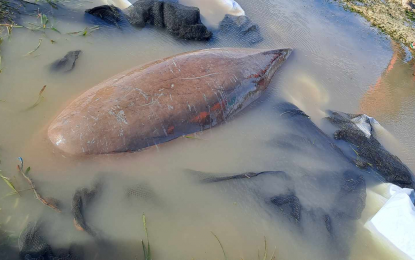
RESCUE. Barangay Bancao-Bancao residents in Puerto Princesa City, Palawan on Thursday (Nov. 30, 2023) team up with Philippine Coast Guard personnel and Large Marine Vertebrates Research Institute Philippines specialists to rescue this dugong from being trapped in a local fish pen. The sea mammal, estimated to weigh about 400 kilos, was trapped in shallow waters as low tide caused the ocean to recede. (Photo courtesy of A. Ballarta)
PUERTO PRINCESA, Palawan – Barangay Bancao-Bancao residents here helped Philippine Coast Guard (PCG) personnel and specialists from the Large Marine Vertebrates Research Institute Philippines (LAMAVE) rescue a mature dugong (scientific name: Dugong dugon) caught in a local fish pen Thursday morning.
Estimated to weigh almost half a ton, the sea mammal was earlier spotted by fishermen grazing on seagrass with a companion, when the onset of low tide trapped it in shallow waters, prompting the animal to seek refuge at a nearby fish pen.
It took the rescuers over eight hours to rescue the dugong, also known as a “sea cow,” and bring it to deeper waters where it quickly recovered and swam toward the open ocean, dodging a potentially fatal entanglement.
PCG Petty Officer 1st Class Andy Villacillo said the dugong, while an endangered species, is a familiar sight in the waters of Bancao-Bancao, where it is often spotted feeding in groups.
"The fishermen here say that they often see two of them together. It has a companion. It's possible that the other one managed to leave before the tide went down. This one, however, really got trapped inside the fish pen," Villacillo said in Filipino.
Sally Snow from LAMAVE emphasized the careful handling required to transport the dugong from the distant fish pen to a safer area, aiming to minimize further distress to the animal.
During the rescue, she said, "We don't want to cause any more distress to the animal. And right now, because it's in a pool [of water], it is good."
LAMAVE, a Filipino non-government organization, is committed to protecting marine megafauna throughout the country.
Dugongs, which reach up to about 3.4 meters in length and weigh as much as 420 kilograms, are notable for their streamlined bodies and large size.
They navigate using their front flippers and possess a distinctive snout, essential for foraging on bottom-dwelling seagrasses.
These gentle and slow-moving creatures play an important role in marine ecosystems, especially in sustaining the health of seagrass beds.
In the Philippines, dugongs are found in various regions, including Palawan and parts of the Visayas, where they are an integral part of the local marine environment.
Despite their ecological importance, these marine mammals face the threat of extinction.
They are endangered due to factors such as habitat degradation, water pollution, and the risk of entanglement in fishing gear.
Illegal hunting, though less common, also poses a threat.
Conservation efforts in the Philippines include habitat protection, research, and community-based initiatives, which are essential to ensure the survival of these unique and significant marine mammals. (PNA)
